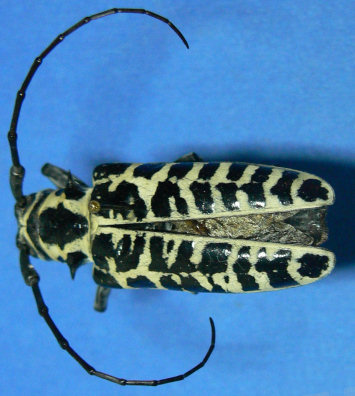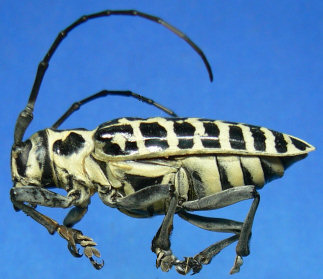 |
TAXONOMY Kingdom Animalia Phylum Arthropoda Class Insecta Order Coleoptera Family Cerambycidae Genus Plectrodera Species Plectrodera scalator Common Name Cottonwood Borer |
 |
Identification
The adults are large, robust, longhorn beetles, 1 to 1.5 inches long. The basic body color is black, but this is obscured by patches and cross stripes of fine, white hairs surrounding
black, hairless areas. This creates a pattern of irregular black patches. There is a strong spine on each side of the thorax and the antennae are as long as the body (females) or a little
longer (males). The larvae are legless, elongate, moderately robust, and yellowish white. They reach a maximum length of about 1.6 inches, but are seldom seen.
|
Natural History
Life cycle
Adult cottonwood borer beetles emerge in midsummer, from mid-May to early-June, and feed only briefly. Females then descend to the base of trees where they gnaw small pits in the bark around the crown and buttress roots. Eggs are deposited in these niches and hatch out after 16 to 18 days. After hatching, larvae bore downward into the inner bark, eventually forming large pupal chambers. Development requires 1 or occasionally 2 years, with pupation occurring in the gallery for about 3 weeks between April and June. New adults chew exit holes out through the sides of the pupal chambers and eventually emerge through the soil to start the cycle again.
Habitat
These beetles generally infest cottonwoods, but can also occur on poplar and willow trees. Larvae of the beetles chew tunnels around roots and form galleries at, or below, the soil line. Larval tunnels can be as long as 8 inches or as wide as 3-inch diameter oval areas. The size of larval tunnels is dependent on the tree size and infestation site. These tunnels are often packed with wood shavings and frass, which is one of the signs of damage in infected trees. Adults live on the same trees, but can be found higher on the host plant during the daytime.
Behavior
Successful reproductive behavior for the beetles is dependent on finding cottonwood or other appropriate host trees. A male cottonwood borer will use pheromones to locate a female near the roots of the tree and immediately mount the female without any courtship. An important consideration with mating is the size of the beetle, as large females are generally not chosen as mating partners. Male and female beetles interact only when mating, and males will aggressively defend their partner from other males. A single male will attempt to dislodge a paired male and female during copulation and subsequently remove sperm of the rival male. Males attempt to defend themselves from being removed by grabbing the antenna of rivals with their strong mandibles. Males will often subsequently guard their female after mating to ensure that their sperm is not removed before egg fertilization.
Diet
Adult beetles feed on the tender shoots of young cottonwood, poplar, and willow trees. This can cause shoots to shrivel and break off, heavily damaging host trees. Larvae feed on the inner phloem of trees, specifically at the root collar and below.
Pest status
The cottonwood borer is considered a pest and is quite detrimental to host trees. Feeding adults can cause shoots to turn black, shrivel up, and eventually die. Although this is not a fatal threat to trees, adults still cause loss of shoots. The real threat comes from the larvae of the beetle. Because larvae bore into the phloem of trees, heavy damage is inflicted on the infrastructure. This heavy damage can increase the change of breakage during storms and significantly shortens the life of trees. Larger trees are more resistant to damage, but young or unhealthy trees are often severely or fatally affected. Proper management by removing and destroying infested trees or locating new nurseries away from infected sites can possibly minimize damage by larvae. Additionally, three weekly applications of insecticide to the lower trunk and surrounding soil soon after adult emergence can control and reduce adult populations.
Distribution
The cottonwood borer can be found throughout the Eastern and Central United States. Although the highest populations are found in the South, the beetle can be found as far north as Washington, D.C. They are apparently absent, however, from the Carolinas and Florida.
References
"Cottonwood Borer". Kansas State University Research and Extension. Entomology 404 Limited Distribution Publication. http://www.oznet.ksu.edu/dp_hfrr/extensn/problems/CottonwoodBorer.htm
Douce, G.K., and D. J. Moorhead. 1989. Insects and diseases of trees in the South. USDA Forest Service – Forest Health Protection. R8-PR18, 98 pp.
Drees, B.M., and J. Jackman. 1999. Field guide to Texas insects. Gulf Publishing Company, Houston.
Driesche, Van G.R. 2006. Invasive forest insects, introduced forest trees, and altered ecosystems. Springer, Netherlands.
Ginzel, D.M, and L.M Hanks. 2003. Contact pheromones as mate recognition cues of four species of longhorned beetles (Coleoptera: Cerambycidae). Journal of Insect Behavior, 16(2):181-187.
Goldsmith, K.S, Z. Stewart, S. Adams, and A. Trimble. 1996. Body size, male aggression, and male mating success in the cottonwood borer, Pectrodera scalator. Journal of Insect Behavior 9(5):719-727.
Photographs by Katrina Weber.
This webpage was created by Katrina Weber and Christina Rivera in partial fulfillment of Entomology, 2007, University of Texas at El Paso. The views in this webpage are based on our research and may not reflect the views of the University of Texas system.